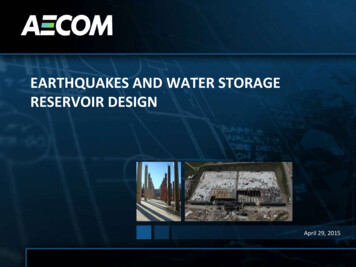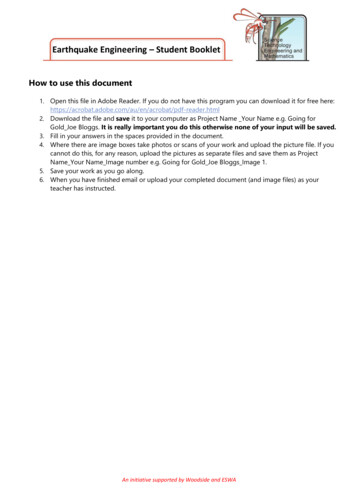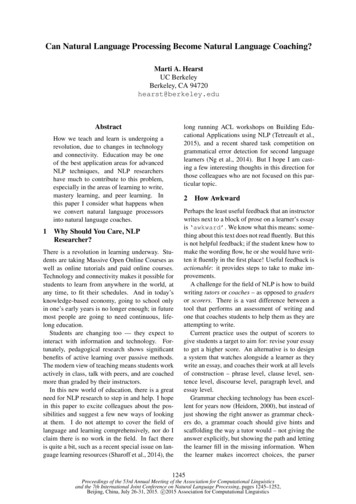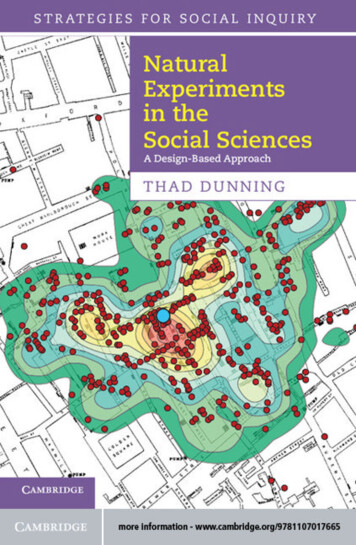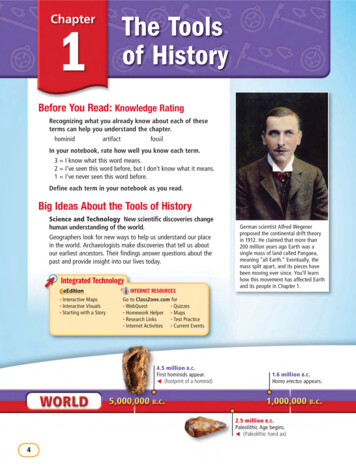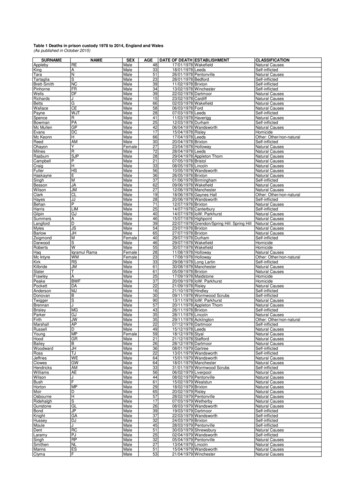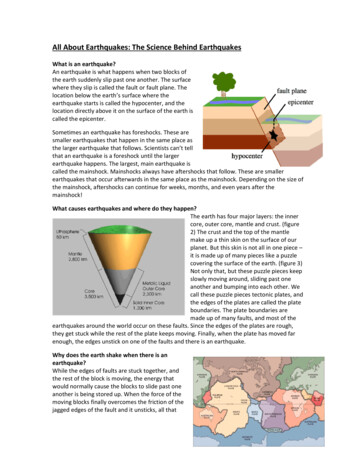
Transcription
All About Earthquakes: The Science Behind EarthquakesWhat is an earthquake?An earthquake is what happens when two blocks ofthe earth suddenly slip past one another. The surfacewhere they slip is called the fault or fault plane. Thelocation below the earth’s surface where theearthquake starts is called the hypocenter, and thelocation directly above it on the surface of the earth iscalled the epicenter.Sometimes an earthquake has foreshocks. These aresmaller earthquakes that happen in the same place asthe larger earthquake that follows. Scientists can’t tellthat an earthquake is a foreshock until the largerearthquake happens. The largest, main earthquake iscalled the mainshock. Mainshocks always have aftershocks that follow. These are smallerearthquakes that occur afterwards in the same place as the mainshock. Depending on the size ofthe mainshock, aftershocks can continue for weeks, months, and even years after themainshock!What causes earthquakes and where do they happen?The earth has four major layers: the innercore, outer core, mantle and crust. (figure2) The crust and the top of the mantlemake up a thin skin on the surface of ourplanet. But this skin is not all in one piece –it is made up of many pieces like a puzzlecovering the surface of the earth. (figure 3)Not only that, but these puzzle pieces keepslowly moving around, sliding past oneanother and bumping into each other. Wecall these puzzle pieces tectonic plates, andthe edges of the plates are called the plateboundaries. The plate boundaries aremade up of many faults, and most of theearthquakes around the world occur on these faults. Since the edges of the plates are rough,they get stuck while the rest of the plate keeps moving. Finally, when the plate has moved farenough, the edges unstick on one of the faults and there is an earthquake.Why does the earth shake when there is anearthquake?While the edges of faults are stuck together, andthe rest of the block is moving, the energy thatwould normally cause the blocks to slide past oneanother is being stored up. When the force of themoving blocks finally overcomes the friction of thejagged edges of the fault and it unsticks, all that
stored up energy is released. The energy radiates outward from the fault in all directions in theform of seismic waves like ripples on a pond. The seismic waves shake the earth as they movethrough it, and when the waves reach the earth’s surface, they shake the ground and anythingon it, like our houses and us!How are earthquakes recorded?Earthquakes are recorded by instruments calledseismographs. The recording they make is called aseismogram. The seismograph has a base that setsfirmly in the ground, and a heavy weight that hangsfree. When an earthquake causes the ground to shake,the base of the seismograph shakes too, but thehanging weight does not. Instead the spring or stringthat it is hanging from absorbs all the movement. Thedifference in position between the shaking part of theseismograph and the motionless part is what isrecorded.How do scientists measure the size of earthquakes?The size of an earthquake depends on the size of the fault and the amount of slip on the fault,but that’s not something scientists can simply measure with a measuring tape since faults aremany kilometers deep beneath the earth’s surface. So how do they measure an earthquake?They use the seismogram recordings made on the seismographs at the surface of the earth todetermine how large the earthquake was (figure 5). A short wiggly line that doesn’t wiggle verymuch means a small earthquake, and a long wiggly line that wiggles a lot means a largeearthquake. The length of the wiggle depends on the size of the fault, and the size of the wiggledepends on the amount of slip.The size of the earthquake is called its magnitude. There is one magnitude for each earthquake.Scientists also talk about the intensity of shaking from an earthquake, and this varies dependingon where you are during the earthquake.How can scientists tell where the earthquake happened?Seismograms come in handy for locating earthquakes too,and being able to see the P wave and the S wave isimportant. You learned how P & S waves each shake theground in different ways as they travel through it. P wavesare also faster than S waves, and this fact is what allows us totell where an earthquake was. To understand how this works,let’s compare P and S waves to lightning and thunder. Lighttravels faster than sound, so during a thunderstorm you willfirst see the lightning and then you will hear the thunder. Ifyou are close to the lightning, the thunder will boom right
after the lightning, but if you are far away from the lightning, you can count several secondsbefore you hear the thunder. The further you are from the storm, the longer it will takebetween the lightning and the thunder.P waves are like the lightning, and S waves are like the thunder. The P waves travel faster andshake the ground where you are first. Then the S waves follow and shake the ground also. If youare close to the earthquake, the P and S wave will come one right after the other, but if you arefar away, there will be more time between the two. By looking at the amount of time betweenthe P and S wave on a seismogram recorded on a seismograph, scientists can tell how far awaythe earthquake was from that location. However, they can’t tell in what direction from theseismograph the earthquake was, only how far away it was. If they draw a circle on a maparound the station where the radius of the circle is the determined distance to the earthquake,they know the earthquake lies somewhere on the circle. But where?Scientists then use a method called triangulation to determine exactly where the earthquakewas (figure 6). It is called triangulation because a triangle has three sides, and it takes threeseismographs to locate an earthquake. If you draw a circle on a map around three differentseismographs where the radius of each is the distance from that station to the earthquake, theintersection of thosethree circles is theepicenter!Can scientists predictearthquakes?No, and it is unlikelythey will ever be able topredict them. Scientistshave tried manydifferent ways ofpredicting earthquakes,but none have beensuccessful. On anyparticular fault,scientists know therewill be another earthquake sometime in the future, but they have no way of telling when it willhappen.Is there such a thing as earthquake weather? Can some animals or people tell when anearthquake is about to hit?These are two questions that do not yet have definite answers. If weather does affectearthquake occurrence, or if some animals or people can tell when an earthquake is coming, wedo not yet understand how it works.
LiquefactionWhat is liquefaction?Liquefaction may occur when water-saturated sandy soils are subjected to earthquake groundshaking. When soil liquefies, it loses strength and behaves as a viscous liquid (like quicksand)rather than as a solid. This can cause buildings to sink into the ground or tilt, empty buried tanksto rise to the ground surface, slope failures, nearly level ground to shift laterally tens of feet(lateral spreading), surface subsidence, ground cracking, and sand blows.Why is liquefaction a concern?Liquefaction has caused significant property damage in many earthquakes around the world,and is a major hazard associated with earthquakes in Utah. The 1934 Hansel Valley and 1962Cache Valley earthquakes caused liquefaction, and large prehistoric lateral spreads exist at manylocations along the Wasatch Front. The valleys of the Wasatch Front are especially vulnerable toliquefaction because of susceptible soils, shallow ground water, and relatively high probability ofmoderate to large earthquakes.Where is liquefaction likely to occur?Two conditions must exist for liquefaction to occur: (1) the soil must be susceptible toliquefaction (loose, water-saturated, sandy soil, typically between 0 and 30 feet below theground surface) and (2) ground shaking must be strong enough to cause susceptible soils toliquefy. Northern, central, and southwestern Utah are the state's most seismically active areas.Identifying soils susceptible to liquefaction in these areas involves knowledge of the localgeology and subsurface soil and water conditions. The most susceptible soils are generally alongrivers, streams, and lake shorelines, as well as in some ancient river and lake deposits.How is liquefaction potential determined?The liquefaction potential categories shown on this map depend on the probability of having anearthquake within a 100-year period that will be strong enough to cause liquefaction in thosezones. High liquefaction potential means that there is a 50% probability of having an earthquakewithin a 100-year period that will be strong enough to cause liquefaction. Moderate means thatthe probability is between 10% and 50%, low between 5 and 10%, and very low less than 5%.What can be done?To determine the liquefaction potential and likelihood of property damage at a site, a sitespecific geotechnical investigation by a qualified professional is needed. If a hazard exists,various hazard-reduction techniques are available, such as soil improvement or specialfoundation design. The cost of site investigations and/or mitigation measures should bebalanced with an acceptable risk.
Liquefaction Maps
All About Earthquakes: Utah Earthquakes1.) Utah Earthquake History-July 18, 1894: Ogden, VI-VII (Mag 5.0)-August 1, 1900: Santaquin, VI-VII-November 13, 1901: Parowan-Richfield, VIII-November 14, 1901: Parowan-Richfield Aftershocks, VII-November 17, 1902: Pine Valley, St. George, Santa Clara, VII-October-December 1909: Series of 30-60 quakes within Garland and Tremonton, VII-May 22, 1910: Salt Lake City, VII (Mag 5.0)-May 13, 1914: Ogden, VII (Mag 5.5)-September 29, 1921: Elsinore, Monroe, Richfield, 2 strong earthquakes 12 hours apart, VIII-March 12, 1934: Kosmo, shore of Great Salt Lake, VIII (Mag 6.6)-August 30, 1962: Franklin, Logan, Preston, Richmond (Cache County) Mag 5.7-October 4, 1967: Marysvale, Mag 5.2-March 28, 1975: Idaho-Utah border, Mag 6.1**See more info at: /history.php2.) Largest Earthquake in Utah-March 12, 1934: Hansel Valley, near Kosmo (30 miles north of Great Salt Lake) Mag 6.6
Newspaper Articles:http://www.seis.utah.edu/lqthreat/nehrp htm/1934hans/n1934ha1.shtml#efhy
3.) Salt Lake City Earthquake-May 22, 1910: Salt Lake City, Mag 5.5Newspaper Articles:http://www.seis.utah.edu/lqthreat/nehrp htm/1910salt/n1910sl1.shtml#tessbsl4.) Wasatch Fault Zone, Salt Lake CityThe Wasatch fault zone is one of the longest and most tectonically active normal faults in NorthAmerica. The fault zone shows abundant evidence of recurrent Holocene surface faulting andhas been the subject of detailed studies for over three decades. Half of the estimated 50 to 120post-Bonneville surface-faulting earthquakes in the Wasatch Front region have been on theWasatch fault zone.This fault has 10 sections. The nearly 350-km-long Wasatch fault zone has traditionally beendivided into seismogenic segments that are thought to rupture at least somewhatindependently. The southern eight sections are entirely in Utah. To the north, the ClarkstonMountain section straddles the state line between Idaho and Utah and the northernmost(Malad City) section is entirely in Idaho. The chronology of surface-faulting earthquakes on theWasatch fault is one of the best dated chronologies in the world and includes 16 earthquakessince 5.6 ka, with an average repeat time of 350 yr. Four of the central five sections [2351e-h]ruptured in the last hundreds to about a thousand years ago, whereas the next section to thenorth, Brigham City [2351d], has not ruptured in the past 2,125 yr. Slip rates of 1-2 mm/yr aretypical for the central sections during Holocene time. In contrast, middle and late Quaternary( 150-250 ka) slip rates on these sections are about an order of magnitude lower. Thissubstantial change in the slip rate may indicate a causal relation between increased Holoceneslip rates and isostatic rebound/crustal relaxation following deep lake cycles such as BonnevilleWhere: Davis County, Salt Lake CountyLand Features: Basin and RangeLength: This section is 43 km of a total fault length of 357 kmSlip rate: Between 1.0-5.0 f web disp.cfm?disp cd B&qfault or 5326&ims cf cd cf
planet. But this skin is not all in one piece – it is made up of many pieces like a puzzle covering the surface of the earth. (figure 3) Not only that, but these puzzle pieces keep slowly moving around, sliding past one another and bumping into each other. We call these puzzle pieces tecton
